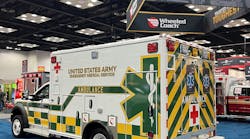French Gulch, CA. Bolgen Creek, AK. Magpie Camp, ND. These small towns are just a few of many sites of wildland fires that occurred during the summer of 2004. In Alaska, approximately 5 million acres had burned by mid-August, an area larger than the states of Connecticut and Delaware combined. Some of those fires were so intense that they melted the permafrost, a layer of earth under the topsoil that in most years stays frozen year-round. That thaw triggered mudslides that covered the Steese Highway in central Alaska.
Whether the setting is a Northern California forest, grasslands in the Northern Plains or the Alaskan wilderness, wildland firefighters can rely on an unusual federal partnership to support their efforts. This federal activity is coordinated by the National Interagency Fire Center (NIFC) and working through a network of fire caches throughout the western United States.
NIFC is a joint effort of the U.S. Department of Agriculture (USDA) Forest Service and other federal entities with responsibility for significant landholdings including the Department of the Interior's Fish and Wildlife Service, the National Parks Service and the Bureau of Land Management (BLM). These agencies contribute personnel and resources to plan for, monitor and contain wildland fires.
Despite advances in technology and the improved predictive capacity of these firefighters, a major fire is still subject to variables as unpredictable as rainfall, weather inversions, wind speed and even the instinct for arson. To stage resources close to fire locations, NIFC operates a network of 11 fire caches throughout the western United States. These caches in turn provide needed supplies to federal, state and local firefighters throughout the fire season.
GSA Global Supply, a business line of GSA's Federal Supply Service (FSS), the federal government's supply operation, manages a distinct program to support this wildland fire community. GSA distributes a fire-products catalog to its government customers and provides continuous access to the approximately 250 items most needed by NIFC. These items include:
- Hand tools used to clear brush and create fire breaks.
- Lanterns, helmets and plenty of batteries lights and radios.
- Protective clothing, including pants, shirts, goggles and gloves.
- Safety equipment, including an emergency shelter. (The emergency fire shelter fits in a lightweight carrying case that clips to the belt of a firefighter. In an emergency, the firefighter removes the shelter and crawls inside the "bag" and finds protection on the ground from both radiant and convective heating.)
- Miscellaneous gear for food service and drinking water needed on the fire line.
One of the challenges of the federal firefighting community is allocating scarce resources, including storage space. Though NIFC operates its fire caches to supply the front lines, it's not always a simple matter to locate additional storage space in communities like Hurley, NM, or Fort Wainwright, AK. Each cache manager must stock up in the spring in anticipation of the summer fire season. But each season brings unpredictable patterns of fires and weather.
In that situation, it's critical that the NIFC program managers be able to rely on GSA Global Supply for re-supply operations. Cache personnel can place orders 24 hours a day and rely on GSA to expedite shipments on demand to meet a critical need. In the course of a "normal" fire season, GSA can expect to ship clothing and other gear for tens of thousands of male and female firefighters, in all shapes and sizes.
In the last complete fire season, during 2003, GSA shipped the following equipment and supplies:
- 1,815 miles of fire hose
- 14,918 shelters
- 80,399 fire pants
- 54,441 fire shirts
- 291,818 fire gloves
- 307,159 canteens
GSA and NIFC work together to ensure that improvements in safety and technology are quickly made available to the front line firefighters. Whether that's updating the fire shelter noted above or testing the brightness and durability of helmet lights, the U.S. Forest Service Technology Centers are constantly testing equipment and evaluating possible improvements.
Results of these testing sessions, along with "lessons learned" in the field are typically exchanged during an annual fire conference. GSA, BLM and the Forest Service take turns hosting this event every November to assess the completed fire season and to begin preparations for the next cycle.
As the Forest Service certifies new items for use in the field, GSA's supply team works to incorporate the new inventory into its distribution facilities and into the catalogs and CDs that customers use to prepare their orders. While funding and space are ongoing concerns for all participants, the focus is always on providing the greatest margin of safety for those at the end of the supply chain.
John Barnicle is a supply specialist for the U.S. General Services Administrations (GSA) Federal Supply Service (FSS).





